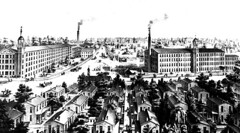David Harvey, Gentrification, and Democracy
I went to a talk by noted geographer social theorist, and former Hampden resident David Harvey this morning. Harvey has been working since the 1960's to understand how cities work in the era of de-industrialized capitalism in which we now find ourselves, and has dealt to some extent with issues of economic equality. His talk today was along those lines. He briefly discussed the development of Baltimore as a city, stressing an increasing collaboration of government interests with private industry - including the land and tax giveaways in the Inner Harbor area with which we are all familiar. He made three important points about Baltimore in general, which - I think - apply very well to Hampden in particular.
1) He said that along with the transformation of Baltimore into a post-industrial city whose economy centers on tourism, shopping and consumption rather than production, has come an ever-increasing gap between the incomes of wealthy people and those of working and poor people.
2) Accompanying this income dispartity is an increase in the well-to- do moving into traditionally working class neighborhoods like Hampden. This drives up housing prices and makes it more difficult for less wealthy people to afford to live in them. In the case of Hampden, it means that people can sell their houses for much more than they bought them for, but leaves them with the problem of finding an affordable place to move to. It also means that the traditional fabric of the neighborhood is beginning to wear a bit thin.
3) He noted that along with these other transformations comes a significant decrease in the ability of people to make their voices heard in the democratic process. Commercial interests seem to constantly have the ear of politicians, drowning out the voices of individual citizens. This means that increasingly, the development plans of the commercial interests, whose focus is primarily on profit, win out over the voices of individuals or civic organizations, whose primary concern is the quality of life in a city or neighborhood.
Gentrification is a major focus of the Hampden project. It certainly has its good points. But it also often happens at the extent of the traditional communities in which it occurrs. One of the reasons that we exist is to try to amplify the voices of people in the community who aren't being heard in the conventional political process - people who see their neighborhood being reinvented as something unrecognizable. This includes the traditional community of Hampden - people who are often left out of decisions about what will happen to the neighborhood that _they_ built. Harvey tells us that in order to increase the democracy and equality of development processes we have to re-imagine the development process itself. We have to strive to hear the voices of all of the stakeholders.
One of the ways that we can do this is through public discussion. Our project hopes to raise such discussion around issues of heritage and public memory. Perhaps we can create some common ground by educating everyone involved about Hampden's rich and fascinating history. I'm interested to hear other views about this. What can we say about the way that development is proceeding in Hampden? What steps can we take to see that the process becomes more democratic?
1) He said that along with the transformation of Baltimore into a post-industrial city whose economy centers on tourism, shopping and consumption rather than production, has come an ever-increasing gap between the incomes of wealthy people and those of working and poor people.
2) Accompanying this income dispartity is an increase in the well-to- do moving into traditionally working class neighborhoods like Hampden. This drives up housing prices and makes it more difficult for less wealthy people to afford to live in them. In the case of Hampden, it means that people can sell their houses for much more than they bought them for, but leaves them with the problem of finding an affordable place to move to. It also means that the traditional fabric of the neighborhood is beginning to wear a bit thin.
3) He noted that along with these other transformations comes a significant decrease in the ability of people to make their voices heard in the democratic process. Commercial interests seem to constantly have the ear of politicians, drowning out the voices of individual citizens. This means that increasingly, the development plans of the commercial interests, whose focus is primarily on profit, win out over the voices of individuals or civic organizations, whose primary concern is the quality of life in a city or neighborhood.
Gentrification is a major focus of the Hampden project. It certainly has its good points. But it also often happens at the extent of the traditional communities in which it occurrs. One of the reasons that we exist is to try to amplify the voices of people in the community who aren't being heard in the conventional political process - people who see their neighborhood being reinvented as something unrecognizable. This includes the traditional community of Hampden - people who are often left out of decisions about what will happen to the neighborhood that _they_ built. Harvey tells us that in order to increase the democracy and equality of development processes we have to re-imagine the development process itself. We have to strive to hear the voices of all of the stakeholders.
One of the ways that we can do this is through public discussion. Our project hopes to raise such discussion around issues of heritage and public memory. Perhaps we can create some common ground by educating everyone involved about Hampden's rich and fascinating history. I'm interested to hear other views about this. What can we say about the way that development is proceeding in Hampden? What steps can we take to see that the process becomes more democratic?

